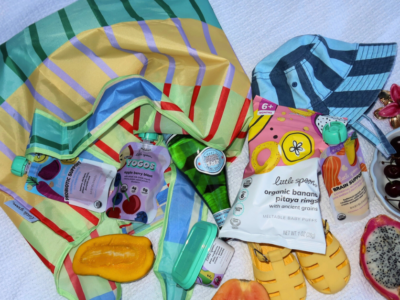This article is reflective of the situation around the country as of May 2021. With the pandemic changing daily, we will continue to provide resources for our community and opportunities to ask questions directly to experts through our digital Facebook community here.
Parents have faced challenging decisions over the course of the pandemic: Should we choose remote or in-person education? Should we plan playdates? Should we take a flight to visit grandparents? The overall strategy in making these decisions is to balance giving children the socialization and structure that they need with reducing the risk of household members developing severe illness due to COVID-19.
With a large portion of adult and young adult Americans being vaccinated against the virus this summer but a vaccine not yet available to our children, the framework we use to guide us through these decisions has changed.
You’ve probably heard by now that COVID-19 does not as significantly impact children’s health as it does adults. This is not to say there is zero risk, but the chance of children having serious complications from COVID19 is low. In an adult vaccinated home, our highest risk household members are now protected from the virus, and therefore the overall risk of severe illness is significantly reduced. Yay for safe and effective vaccines!
This coupled with lower infection rates in most parts of the country and a warm climate is good news for your summer plans! But, the risk to children is not nil—we know children can transmit the virus and this transmission over time could lead to variants of the virus which may not be covered by our current vaccines—so we must continue to be thoughtful and deliberate with our decisions as it pertains to our unvaccinated children.
As a pediatrician, here are some of the most common topics discussed related to covid safety this summer and how I approach them:
Spending time with grandparents or other vaccinated adults
When thinking about this decision the latest CDC guidance for vaccinated people comes into play. We know the CDC’s guidance is ever changing but at the time this article was written, it stated “fully vaccinated people can visit without masks indoors with other fully vaccinated people and with unvaccinated people from one household as long as everyone in the household is low risk for developing severe COVID-19”. Children are generally considered low risk unless they have an underlying condition.
Essentially, if your child(ren) does not have an underlying condition, visiting with a fully vaccinated adult indoors without masks is considered a low-risk activity. If your child does have an underlying condition, I think this is worth a discussion with your pediatrician to think through the nuances.
Playdates
One of the many things that the pandemic has taught us is the benefits of socialization on children’s well-being. Since children are not yet vaccinated, the CDC is still cautioning to limit in-person playtime and encouraging connecting virtually with other children. As a parent, I understand how challenging this can be on families and as a pediatrician I’ve witnessed the detriments that a lack of socialization can have on children.
I encourage each family to make a decision based on their risk level and risk tolerance and then take steps to reduce risk from there. To minimize risk I recommend scheduling playdates with members of the same “pod” or group of friends who are practicing similar safety measures as your family and planning lower risk activities such as staying outdoors. I also would ensure the children in both parties have not experienced symptoms of COVID-19 (i.e. runny nose, congestion, fever) in the last 10 days. If they have experienced symptoms they should be resolved before meeting and if the playdate is within 10 days of the start of their symptoms I would recommend the symptomatic child have a negative COVID-19 test before meeting. I also suggest parents have an open conversation about expectations and comfort level prior to playdates to ensure all parties are aligned.
Traveling via plane
The CDC has updated airplane travel guidance stating fully vaccinated individuals can safely travel within the United States while still following CDC recommendations including wearing a mask, social distancing and hand hygiene, but continues to encourage unvaccinated individuals to limit airplane travel to essential trips. In the scenario of vaccinated parents traveling with unvaccinated children, parents should consider risk factors taking into account their personal circumstances and make a decision based on their comfort level. If the decision to travel is made, unvaccinated children should follow testing and quarantine protocols advised by the department of health of the given area traveling to and from.
The risk of COVID transmission via airplane travel is not as much from the flight itself (particularly given mask wearing regulations and safety precautions carriers are taking), but is rather from being in close quarters with others in airports and taxi lines and from activity at the destination. When considering the decision, factors to take into account are whether your child has an underlying condition putting them at higher risk, the infection rates of the areas you are traveling to and from, the mode of transportation you are taking to and from the airport and the type of activity and amount of mixing with non-household members at the destination. To reduce risk I’d suggest mask wearing for children over the age of 2 that can tolerate it during travel, hand hygiene during travel, flights with the fewest layovers, flights during less busy hours, avoiding long train/bus rides and avoiding activities in which you are in close contact with non-household members at the destination.
Summer camp
Camp, whether it’s a daycamp or overnight camp, is a good opportunity for kids to reconnect and expend physical activity which is so important for well-being, particularly after a challenging school year. More than a year into the pandemic we’ve learned that transmission of COVID-19 in the camp and school setting is limited when the proper safety precautions are followed. Moreover, having vaccinated staff and potentially older campers further limits spread. When deciding on a camp, it’s important to take into account the safety precautions a camp is implementing such as: prevention strategies like masking, distancing and cohorting; how many children are in each cohort; if there is mixing between cohorts; how much time is spent outdoors versus indoors; screening for COVID-19 symptoms in camp goers and staff and testing for COVID-19,which can be particularly useful in overnight camp settings where campers are co-rooming.
Like most of parenting, these decisions are never easy. My best advice: go with what feels right and don’t look back.



